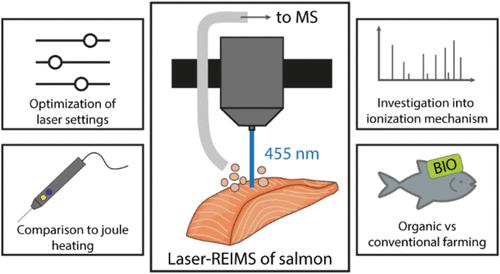商用蓝色二极管激光雕刻机工作在455nm作为一个负担得起的LD-REIMS电离源
IF 6.7
1区 化学
Q1 CHEMISTRY, ANALYTICAL
引用次数: 0
摘要
激光通常用于质谱应用,以执行激光烧蚀-解吸和电离;然而,可见光的使用并不常见。在这里,我们报告了一种市售的可见光激光雕刻机,在455nm作为电离源工作,产生丰富的光谱剖面,主要以脂类物质为特征,如脂肪酸和甘油磷脂。对样品上的移动速度和激光功率等激光设置进行了测试,结果表明,用于分析新鲜鲑鱼组织样品的最佳激光速度为300 mm/min,激光功率为30-50%。产生的光谱与使用焦耳加热组织的传统REIMS机制产生的光谱相似,这一点通过离子形成机制的比较研究得到了巩固。生成的光谱在较低质量范围内信号略高,表明源内破碎程度较高;然而,两种方法都没有独特的光谱特征。为了测试可见光激光系统作为一种类似reims的食品真实性分析技术的适用性,我们评估了使用传统和有机耕作方法生产的挪威养殖鲑鱼样本(n = 26)的鉴别性。本文章由计算机程序翻译,如有差异,请以英文原文为准。

Commercially Available Blue Diode Laser Engraver Operating at 455 nm as an Affordable LD-REIMS Ionization Source
Lasers are commonly used for mass spectrometric applications to perform laser ablation–desorption and ionization; however, the use of visible light is not very common. Here, we report a commercially available visible light laser engraver operating at 455 nm as an ionization source, generating rich spectral profiles featuring predominantly lipid species, such as fatty acids and glycerophospholipids. Laser settings such as the speed of movement over the sample and laser power were tested, resulting in an optimum laser speed of 300 mm/min and a laser power of 30–50% for the analysis of fresh salmon tissue samples. Spectra generated were found to be similar to those produced by a conventional REIMS mechanism using Joule heating of the tissues, which was consolidated by comparative studies of the ion formation mechanism. The generated spectra show a slightly higher signal in the lower mass range, suggesting a higher degree of in-source fragmentation; however, no spectral feature was unique to either method. To test the suitability of the visible laser system to act as an REIMS-like profiling technique for food authenticity testing, we assessed the discrimination of Norwegian farmed salmon samples (n = 26) produced using conventional and organic farming methods.
求助全文
通过发布文献求助,成功后即可免费获取论文全文。
去求助
来源期刊

Analytical Chemistry
化学-分析化学
CiteScore
12.10
自引率
12.20%
发文量
1949
审稿时长
1.4 months
期刊介绍:
Analytical Chemistry, a peer-reviewed research journal, focuses on disseminating new and original knowledge across all branches of analytical chemistry. Fundamental articles may explore general principles of chemical measurement science and need not directly address existing or potential analytical methodology. They can be entirely theoretical or report experimental results. Contributions may cover various phases of analytical operations, including sampling, bioanalysis, electrochemistry, mass spectrometry, microscale and nanoscale systems, environmental analysis, separations, spectroscopy, chemical reactions and selectivity, instrumentation, imaging, surface analysis, and data processing. Papers discussing known analytical methods should present a significant, original application of the method, a notable improvement, or results on an important analyte.
 求助内容:
求助内容: 应助结果提醒方式:
应助结果提醒方式:


